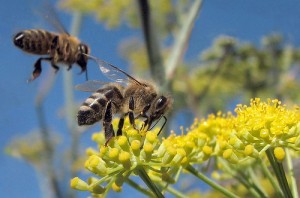
Last time I talked about beneficial birds for use in gardening. Now let’s look at beneficial insects – more specifically, bees. Before you get out your fly swatter, you may want to reconsider your attitude toward this necessary element of plant pollination (and thereby, seed production).
Bees are necessary for the pollination and continued existence of many, many crops and fruits. These include okra, onion, celery, beets, broccoli, cauliflower, cabbage, fruit trees and bushes, and so many others, it would take the whole newsletter to list. The problem is the honey bee population is declining – dramatically.
And scientists are unsure why.
The number of beehives dropped 32 percent in 2007, 36 percent in 2008, and 29 percent in 2009. It’s being called “colony collapse disorder” and is happening worldwide. While beekeepers and researchers have looked at various causes like viruses or parasites, they’ve been unable to zero in on one specific factor. With record freezing temperatures from this past winter, the percentage of decline is estimated at 30 to 50 percent more, according to the president of the American Beekeeping Federation.
Pesticides appear to be a major contributing factor in the bee population crisis. Samples of bee hives in various states and Canada found over 100 different pesticides in the bees, wax, pollen and other elements of the hives. One of the most detrimental pesticides to bees is Sevin dust (a favorite of home gardeners!) according to the president of the Mississippi Beekeepers Association. The dust adheres to the legs and body of the bee and is carried back into the hive.
If we want to have a continued heirloom seed crop from our vegetables and fruits, we’re going to have to learn to use more organic means of pest control. We’re going to have to encourage a bird and insect population that feeds on the bad stuff. We need to grow plants and herbs amongst our vegetables and fruits that can coexist without cross-pollinating and that deter destructive insects.
Feral, or wild, honeybee populations are almost gone. The colonies that are enjoying the most success are those managed by people. It takes commitment and time to tend to these creatures, but in the ironic symbiotic relationship we have with bees, we need them as much as they need us.
I would encourage you to consider making the investment in a beehive colony. There’s a lot to managing bees, so don’t just jump out there and buy a hive body and a package of bees and think you’re in business. Go to your local county extension agent and request more information. There are also books and unlimited online resources as well. In addition, if you find a wild hive encroaching in your living area, please call your local sheriff’s department who will have the names of local beekeepers that can come and remove the hive. If at all possible, do not destroy the colony.
The way we care for our bees may be the very thing that insures our continued existence and the survival of our heirloom seed stock.